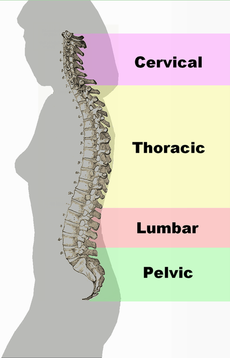- Neutral spine
-
Neutral spine Classification and external resources 
Different regions (curvatures) of the vertebral columnICD-10 M54 ICD-9 724.5 DiseasesDB 15544 MeSH D001416 A neutral spine or good posture refers to the "three natural curves [that] are present in a healthy spine."[1]
Contents
Posture
The word "posture" comes from the Latin verb "ponere" which is defined as "to put or place." The general concept of human posture refers to "the carriage of the body as a whole, the attitude of the body, or the position of the limbs (the arms and legs)."[2]
Webster's New World Medical Dictionary defines "neutral posture" as the stance which is attained "when the joints are not bent and the spine is aligned and not twisted." [3] In this position, a person is able to completely and optimally attain balance and proportion of his or her body mass and framework, based on his or her physical limitations. Good posture optimizes breathing and affects the circulation of bodily fluids.
Natural curvatures
In medicine and occupations concerned with physical fitness, the concept of good posture is referred to as "neutral spine."[4] In this context, proper posture or "neutral spine," is the proper alignment of the body between postural extremes. In its natural alignment, the spine is not straight. It has curves in the thoracic (upper) and lumbar (lower) regions. There is a slight forward curve in the lumbar region (lordosis), a slight backward curve in the thoracic region (kyphosis) and a slight extension in the tiny cervical vertebra at the top of the spine. In addition, the ears, shoulders, hips, knees and ankles are aligned as if a plumb line were running from the ears down through the torso into the legs and the feet. In neutral posture, the body is able to function in its strongest, most balanced position. Stress to the joints, muscles, vertebrae and tissue is minimized.[4]
In contrast, a non-neutral spine leads to "improper posture, [that] especially when walking, puts increased stress on your back and causes discomfort and damage." When the spine is left in non-neutral posture for extended periods of time, it raises the diaphragm, preventing the body from taking a full breath. This can lead to reduced oxygenation throughout the body. It can also compromise the internal organs' performance by putting pressure throughout the abdomen. [5] People who sit for long hours on the job are susceptible to a number of misalignments."[6]
"Neutral spine" is ideally maintained while sitting, standing, and sleeping.[7]
See also
- Alexander Technique
- Physical fitness
- Squatting position
References
- ^ A Patient's Guide to Rehabilitation for Low Back Pain: Understanding the Neutral Spine Position, http://www.umm.edu/spinecenter/education/rehabilitation_for_low_back_pain.htm
- ^ Definition of Posture, Webster's New World Medical Dictionary, http://www.medterms.com/script/main/art.asp?articlekey=9731
- ^ Definition of Neutral Posture, Webster's New World Medical Dictionary, http://www.medterms.com/script/main/art.asp?articlekey=25488
- ^ a b Webster, Deborah, The Neutral Spine, wellbridge.com, http://www.wellbridge.com/wellbridge/cambridge/pulse.php?ID=9
- ^ www.thesoarmethod.com
- ^ Vogel, Amanda (2001), Helping Clients Find Neutral Spine, ACE Certified News
- ^ Markusic, Jeanne, Maintaining a Healthy Spine - Posture, http://www.spineuniverse.com/displayarticle.php/article183.html
External links
- A Patient's Guide to Rehabilitation for Low Back Pain: Understanding the Neutral Spine Position. University of Maryland Medical Center Spine Program, June 19, 2008.
- Sitting straight 'bad for backs'. BBC News, 28 November 2006
Categories:- Spinal cord
- Exercise
- Prevention
- Health
Wikimedia Foundation. 2010.
